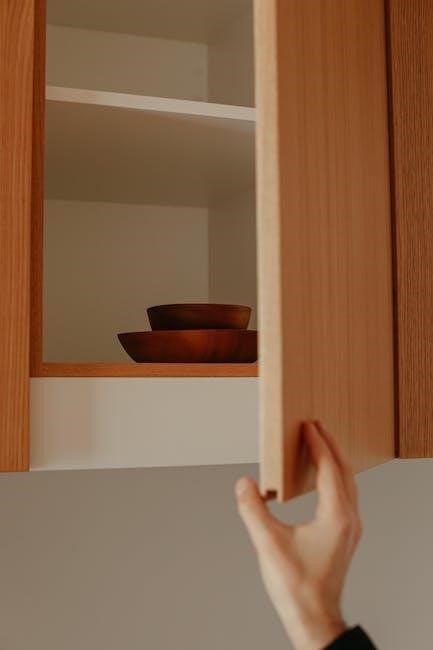A manual lensometer, or focimeter, is a crucial optometric tool used to measure the spherical, cylindrical, and axis powers of eyeglass lenses, ensuring accurate prescription fulfillment.
1.1 Overview of the Manual Lensometer
A manual lensometer, also known as a focimeter, is an essential optical instrument used to measure the spherical, cylindrical, and axis powers of eyeglass lenses. It ensures that lenses are fabricated to the correct prescription, making it a vital tool in optometry. The device operates on the Badal Principle, utilizing a telescopic system to detect parallel rays, ensuring accurate measurements. Its simplicity and precision make it a cornerstone in verifying lens parameters for both single vision and multifocal lenses, guaranteeing optimal vision correction.

What is a Manual Lensometer?
A manual lensometer is an optical tool used to measure the spherical, cylindrical, and axis powers of eyeglass lenses, ensuring accurate prescription verification in optometry.
2.1 Definition and Purpose
A manual lensometer, also known as a focimeter, is a precision optical instrument designed to measure the refractive properties of eyeglass lenses. Its primary purpose is to verify the accuracy of a lens prescription by determining the spherical power, cylindrical power, and axis alignment. This ensures that the lenses meet the specified optical requirements for correcting vision. The device is essential in optometry for quality control and prescription verification, providing accurate and reliable measurements.
2;2 Types of Lensometers
Lensometers are available in two primary types: manual and automated. Manual lensometers are cost-effective, portable devices that rely on mechanical adjustments to measure lens parameters. Automated lensometers, in contrast, use digital technology for faster and more precise measurements. Both types serve the same purpose but cater to different needs, with manual models being ideal for basic use and automated versions suited for high-volume optical labs and modern practices.
Working Principle of a Manual Lensometer
A manual lensometer operates on the Badal principle, using a telescope to detect parallel rays at neutralization, ensuring precise measurement of lens parameters through optical alignment.
3.1 The Badal Principle
The Badal principle, a fundamental concept in lensometry, enables precise measurement of lens parameters by detecting parallel rays at neutralization. This principle integrates a telescope system to align the lens being measured with a fixed target. When light passes through the lens, the telescope focuses on the target, allowing the operator to accurately determine the spherical and cylindrical powers by adjusting the power drum and axis wheel. This optical alignment ensures accurate and reliable measurements, essential for optometric applications.
3.2 Optical Components and Their Functions
The manual lensometer consists of key optical components, including the eyepiece, power drum, cylinder axis wheel, and reticle. The eyepiece focuses light for clear viewing, while the power drum adjusts spherical power measurements. The cylinder axis wheel aligns astigmatism correction, and the reticle provides reference lines for measuring lens parameters. Together, these components ensure precise optical alignment and accurate detection of lens powers, enabling reliable measurement of spherical, cylindrical, and axis values in eyeglass lenses.

Parts of the Manual Lensometer
A manual lensometer comprises an eyepiece, power drum, axis wheel, and reticle. These components work together to focus light and measure lens parameters accurately.
4.1 External Components
The manual lensometer features an eyepiece for focusing, a power drum to adjust spherical power, and an axis wheel to align cylindrical measurements. A reticle with measurement lines aids in reading lens parameters. The stage securely holds eyeglasses, and a tilting mechanism ensures ergonomic operation. These components are designed for precise optical alignment and user comfort during lens analysis.
4.2 Internal Optical System
The internal optical system of a manual lensometer includes a Badal prism for precise measurement of lens parameters. An illuminated target and a telescope are aligned with the lens under test, enabling accurate detection of optical properties. This system ensures that measurements are taken based on parallel light rays, maintaining consistency and reliability in determining spherical power, cylindrical power, and axis alignment.

Calibration and Setup
The manual lensometer’s internal optical system relies on a Badal prism and telescope to align with the lens under test. This setup ensures precise measurement of spherical, cylindrical, and axis powers by detecting parallel light rays, crucial for accurate readings. The system’s design maintains consistency and reliability in optical assessments, making it essential for optometric applications.
5.1 Initial Calibration Steps
Begin by turning on the lensometer and focusing the eyepiece for your eye. Set the power drum to zero and align the reticle lines for clarity. Use a plano lens as a reference to ensure the device reads zero for sphere, cylinder, and axis. Adjust the eyepiece focus if necessary, ensuring all lines are sharp. This step ensures accurate baseline measurements and prevents errors during lens analysis.
5.2 Proper Setup for Accurate Measurements
Position the lensometer at a comfortable angle and ensure the eyepiece is focused for your eye. Place the eyewear on the stage, temples facing away, and center the lens on the lens stop. Lock it firmly to prevent movement. Adjust the stage height to align the lens with the reticle. Ensure the eyepiece is focused and the reticle lines are sharp. Proper alignment of the lens center with the reticle is critical for accurate readings. This setup ensures precise measurement of lens parameters.

Measurement Procedure
Focus the eyepiece, position the lens, and use the power drum to align spherical and cylindrical lines. Adjust the axis wheel for astigmatism and record the readings accurately.
6.1 Steps to Measure Lens Parameters
Focus the eyepiece and position the lens on the stage. Align the reticle lines with the lens center. Adjust the axis wheel to straighten spherical lines for astigmatism. Use the power drum to focus spherical and cylindrical lines, noting the readings. For bifocal lenses, center the segment and measure the add power. Ensure accurate alignment and focus to obtain precise spherical, cylindrical, and axis values, essential for verifying the prescription and lens accuracy.

Reading Different Types of Lenses
A manual lensometer measures spherical, cylindrical, and axis parameters for single vision, bifocal, and progressive lenses, with techniques varying to ensure accurate readings for each type.
7.1 Single Vision Lenses
Measuring single vision lenses with a manual lensometer focuses on determining spherical power. The process involves focusing the eyepiece, positioning the lens, and aligning the reticle. By turning the power drum, the spherical lines are brought into focus, providing the lens’s spherical power. Since single vision lenses lack astigmatism correction, the measurement is straightforward, requiring only the spherical power to complete the reading. This ensures accurate prescription verification for single vision corrections.
7.2 Bifocal and Progressive Lenses
Measuring bifocal and progressive lenses requires careful alignment to ensure accurate readings. For bifocals, center the distance portion first, measure the spherical power, then reposition to measure the near segment. Progressive lenses demand precise alignment to capture the gradual power transition. The lensometer’s reticle helps identify the near add power by focusing on the segment’s center. Accurate measurement ensures proper vision correction across all lens zones, critical for patient comfort and optical clarity.

Maintenance and Troubleshooting
Regularly clean optical components and check alignment for accuracy. Handle with care to avoid damage. Troubleshoot issues like blurry images by adjusting mirrors or recalibrating the device.
8.1 Regular Maintenance Tips
Regular maintenance ensures optimal performance. Clean the eyepiece and objective lenses with soft, dry cloth to prevent dust buildup. Check alignment periodically and recalibrate if necessary. Store the device in a protective case when not in use. Avoid exposure to harsh chemicals or extreme temperatures. Lubricate moving parts if they become stiff. Regularly inspect and replace worn components to maintain accuracy. Schedule professional servicing annually for complex adjustments.
8.2 Common Issues and Solutions
Common issues with manual lensometers include blurry images, which can be resolved by adjusting the eyepiece focus. Misaligned components may cause inaccurate readings; recalibrating the device often fixes this. Dust or smudges on the lenses can distort measurements; clean them with a soft cloth. If the power drum is stiff, lubricate moving parts. For inconsistent readings, ensure proper setup and check for wear. Regular maintenance and timely repairs help prevent these issues, ensuring precise and reliable measurements.
The manual lensometer is an essential tool in optometry, ensuring accurate lens measurements and contributing significantly to precise eyewear prescriptions and patient care.
9.1 Summary and Importance in Optometry
The manual lensometer is a fundamental tool in optometry, enabling precise measurements of lens parameters to ensure accurate prescriptions and patient care. Its ability to measure spherical, cylindrical, and axis powers makes it indispensable for verifying eyewear accuracy. Proper use guarantees precise neutralization, providing a reliable starting point for refractions. As a cornerstone in optometric practices, the manual lensometer remains vital for delivering high-quality vision correction solutions, emphasizing its enduring importance in the field.